Asha code of ethics - Study guides, Class notes & Summaries
Looking for the best study guides, study notes and summaries about Asha code of ethics? On this page you'll find 60 study documents about Asha code of ethics.
Page 4 out of 60 results
Sort by
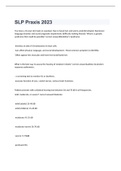
-
SLP Praxis 2023 exam 2023 with 100% correct answers
- Exam (elaborations) • 7 pages • 2023
-
Available in package deal
-
- $12.49
- + learn more
You have a 16-year-old male on caseload. Has no facial hair and seems underdeveloped. Expressive language disorder and social pragmatic impairments (difficulty making friends). What is a genetic syndrome that could be possible? Klinefelter's Syndrome -Involves an extra X chromosome in most cells. -Can affect physical, language, and social development. -Most common symptom is infertility. -Often appear less muscular and have less facial/body hair. What is the best way to assess the ...
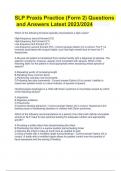
-
SLP Praxis Practice Questions and Answers Latest Updated 2024 (Graded A+)
- Exam (elaborations) • 37 pages • 2024
-
Available in package deal
-
- $15.49
- + learn more
SLP Praxis Practice Questions and Answers Latest Updated 2024 (Graded A+) Which of the following formants typically characterizes a high vowel? High-frequency second formant (F2) High-frequency first formant (F1) Low-frequency first formant (F1) Low-frequency second formant (F2) - Correct answer-Option (C) is correct. The F1 is inversely associated with tongue height, such that high vowels tend to have low F1 frequencies. A 65-year-old patient is transferred from another facility with a d...
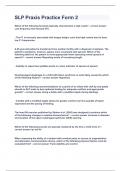
-
SLP Praxis Practice Form 2|2023 LATEST UPDATE|GUARANTEED SUCCESS
- Exam (elaborations) • 32 pages • 2023
-
Available in package deal
-
- $19.99
- + learn more
Which of the following formants typically characterizes a high vowel? Low-frequency first formant (F1) - The F1 is inversely associated with tongue height, such that high vowels tend to have low F1 frequencies. A 65-year-old patient is transferred from another facility with a diagnosis of aphasia. The patient's symptoms, however, appear more consistent with apraxia. Which of the following tasks for the patient is most appropriate when assessing verbal apraxia of speech? Repeating wo...
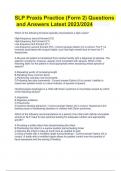
-
SLP Praxis (Form 2) Exam Questions and Answers | Latest Update 2023/2024 (Graded 100%)
- Exam (elaborations) • 37 pages • 2023
- Available in package deal
-
- $17.99
- + learn more
SLP Praxis (Form 2) Exam Questions and Answers | Latest Update 2023/2024 (Graded 100%). A 65-year-old patient is transferred from another facility with a diagnosis of aphasia. The patient's symptoms, however, appear more consistent with apraxia. Which of the following tasks for the patient is most appropriate when assessing verbal apraxia of speech? A.Repeating words of increasing length B.Recalling three common items C.Performing voluntary oral movements D.Following two-step commands - ...

-
SLP Praxis Practice (Form 2)|2023 LATEST UPDATE|GUARANTEED SUCCESS
- Exam (elaborations) • 44 pages • 2023
-
Available in package deal
-
- $14.99
- + learn more
Which of the following formants typically characterizes a high vowel? High-frequency second formant (F2) High-frequency first formant (F1) Low-frequency first formant (F1) Low-frequency second formant (F2) Option (C) is correct. The F1 is inversely associated with tongue height, such that high vowels tend to have low F1 frequencies. A 65-year-old patient is transferred from another facility with a diagnosis of aphasia. The patient's symptoms, however, appear more consistent with a...

-
Orientation and Mobility Study Guide Questions with Correct Answers
- Exam (elaborations) • 6 pages • 2024
-
Available in package deal
-
- $11.99
- + learn more
Orientation and Mobility Study Guide Questions with Correct Answers What is the code of ethics for ACVREP - Correct Answer 1. Student, community profession, colleagues, employment practices AER - Correct Answer 1. Association for the education and rehabilitation of the blind ASHA - Correct Answer 1. American speech language and hearing association 2. Association for speech and language How did C. BLEDSOE influence the advancement of the O&M profession - Correct Answer ...
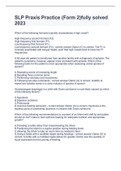
-
SLP Praxis Practice (Form 2)fully solved 2023
- Exam (elaborations) • 37 pages • 2023
-
Available in package deal
-
- $25.49
- + learn more
SLP Praxis Practice (Form 2)fully solved 2023Which of the following formants typically characterizes a high vowel? High-frequency second formant (F2) High-frequency first formant (F1) Low-frequency first formant (F1) Low-frequency second formant (F2) Option (C) is correct. The F1 is inversely associated with tongue height, such that high vowels tend to have low F1 frequencies. A 65-year-old patient is transferred from another facility with a diagnosis of aphasia. The patient's sym...
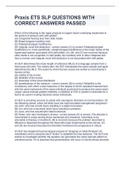
-
Praxis ETS SLP QUESTIONS WITH CORRECT ANSWERS PASSED
- Exam (elaborations) • 10 pages • 2023
-
Available in package deal
-
- $15.49
- + learn more
Praxis ETS SLP QUESTIONS WITH CORRECT ANSWERS PASSEDWhich of the following is the major physical or organic factor underlying impairment in the speech of persons with cleft palate? (A) Congenital hearing loss from otitis media (B) Broad irregular maxillary arch (C) Palatopharyngeal insufficiency (D) Irregular vocal fold abduction (C) is correct. Palatopharyngeal insufficiency or, more specifically, velopharyngeal insufficiency is the major cause of the hypernasal speech associated with clef...
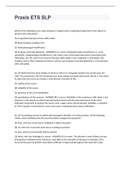
-
Praxis ETS SLP exam 2022/2023 with 100% correct answers
- Exam (elaborations) • 11 pages • 2022
-
- $8.99
- + learn more
Which of the following is the major physical or organic factor underlying impairment in the speech of persons with cleft palate? (A) Congenital hearing loss from otitis media (B) Broad irregular maxillary arch (C) Palatopharyngeal insufficiency (D) Irregular vocal fold abduction (C) is correct. Palatopharyngeal insufficiency or, more specifically, velopharyngeal insufficiency is the major cause of the hypernasal speech associated with cleft palate. (A), (B), and (C) are incorrect because ot...
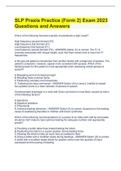
-
SLP Praxis Practice (Form 2)
- Exam (elaborations) • 37 pages • 2023
-
Available in package deal
-
- $9.99
- + learn more
Which of the following formants typically characterizes a high vowel? High-frequency second formant (F2) High-frequency first formant (F1) Low-frequency first formant (F1) Low-frequency second formant (F2) - ANSWER-Option (C) is correct. The F1 is inversely associated with tongue height, such that high vowels tend to have low F1 frequencies. A 65-year-old patient is transferred from another facility with a diagnosis of aphasia. The patient's symptoms, however, appear more consistent wi...

How did he do that? By selling his study resources on Stuvia. Try it yourself! Discover all about earning on Stuvia


